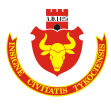Tykocin
| Tykocin | ||
|---|---|---|

|
|
|
| Basic data | ||
| State : | Poland | |
| Voivodeship : | Podlaskie | |
| Powiat : | Białostocki | |
| Gmina : | Tykocin | |
| Geographic location : | 53 ° 12 ' N , 22 ° 46' E | |
| Height : | 127 m npm | |
| Residents : | 1995 (December 31, 2016) | |
| Postal code : | 16-080 | |
| Telephone code : | (+48) 85 | |
| License plate : | BIA | |
| Economy and Transport | ||
| Next international airport : | Warsaw | |
Tykocin (Yiddish: Tiktin ) is a city in the powiat Białostocki of the Podlaskie Voivodeship in Poland . It is the seat of the town-and-country municipality of the same name with about 6300 inhabitants and is located about 20 kilometers west of Białystok in the Biebrza valley on the Narew River .
Tykocin has one of the best preserved historical city centers in Poland. Before the Second World War it was one of the most important centers of Polish Jewry. The touristically popular place and received, among other things, an award as a European stork village .
history
Between the 11th and 14th centuries there was a castle of the Dukes of Mazovia nearby . As a result of the growing trade between Poland and the Grand Duchy of Lithuania , new, shorter trade routes were created in the 14th century. Tykocin was formed at one of them, at the Narew crossing. In 1425 Duke Janusz I. Starszy granted him city rights under Kulm law . After a temporary affiliation to Lithuania, the city was presented to the hetman Stefan Czarniecki in 1656 as a thank you for his victories against the Swedes. In 1705, King Augustus the Strong founded the Order of the White Eagle , the oldest and most important order in Poland , in Tykocin . During the Third Partition of Poland in 1795, Tykocin fell to Prussia, in 1807 it belonged to the Duchy of Warsaw and in 1815 it became part of the Russian Congress of Poland . In the course of the Soviet occupation of Eastern Poland in 1939 , the Red Army marched into Tykocin, which was followed by the German Wehrmacht after the German invasion of the Soviet Union in 1941 , which exercised a reign of terror that almost completely killed the Jewish population. As a result of the war, the town charter was lost from 1950 to 1993. From 1975 to 1998 Tykocin was part of the Białystok Voivodeship .
Jewish history
The first record of Jews in Tykocin dates back to 1522, when ten families from Grodno were settled to promote trade. In 1576 the king granted a general right of residence, which was confirmed in 1633. In 1800 about 70% of the city's population were Jews, before the outbreak of World War II it was still about 50%. After the German invasion in 1941, the remaining 1,400 Jews were murdered in the Tykocin massacre in the forest near the town of Łopuchowo .
Attractions
- Trinity Church and ensemble of the former missionary monastery (1742–1749)
- Baroque market place
- Great Synagogue from 1642, now the Museum of Jewish Culture
- Small synagogue , now the city museum
- Talmud House, now a museum and Jewish restaurant
- Small market, former center of the Jewish quarter
- Former hospital from 1755
- Former military veterans' home 1634–1638, the oldest in Poland
- Complex of the Bernardine monastery built between 1771 and 1790 on the initiative of Jan Klemens Branickis
- 2005 partially rebuilt ruins of the castle of King Sigismund Augusts
- Jewish Cemetery
- Monument to Stefan Czarniecki from 1763, probably the oldest secular monument in Poland
Gmina
The town-and-country municipality of Tykocin has 34 school offices , which extend over an area of 207 square kilometers.
Personalities
- Jan Klemens Branicki (1689–1771), Polish general
- Michał Jankowski (1842–1912), Polish-Russian entrepreneur, naturalist, entomologist and animal breeder
- Wacław Łopuszyński (1856–1929), Polish locomotive engineer
- Chaim Siemiatycki (* 1908), Yiddish poet




